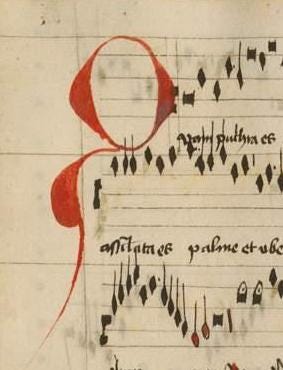This Substack has been a long time coming. For years I have wanted a place where I could share my ideas about what makes something beautiful, but for some reason just never found the right place. I thought I would find it in academia as a music historian, but that didn’t work out. I thought I’d find it in the fashion world as a clothing designer, but that really didn’t work out. Then I thought, forget pursuing beauty as a career. I’ll just try and live as happy a life I can as a very well-paid secretary! That worked out really well until I got fired a few months later.
But here I am now, a bit more settled career-wise, wanting to give the beautiful another try. I decided to title this introduction “Quam pulchra es” after a motet I really like by the English composer John Dunstable (1390-1453). Dunstable was setting some of the Song of Songs to 3-part harmony, and these few words mean “How beautiful.”
Few things in life make me happier than stumbling upon something beautiful, whether it is a sound, an image or an idea. I grew up playing the violin and became a born-again musician in high school while experiencing the music of Gustav Mahler (1860-1911) in youth orchestra. I don’t use the term “born-again” lightly; the experience really was quite mystical and I remember it like it was yesterday. We were rehearsing the waltz movement of Mahler’s first symphony, and as a second violinist I had a simple harmony to accompany the main melody. After the phrase ended and we were dismissed for a break, I flew out of the rehearsal hall, positively euphoric, screaming, “MUSIC! MUSIC!” to anyone who would listen. (Actually I was probably screaming so loud that I made people listen.) I then ran around the building jumping for joy, feeling like I had somehow become a brand new person.
The thing is I’m not sure what was so extraordinary about that short phrase as to elicit such a response. Was it maybe the image of fin-de-siècle Viennese, waltzing their way into world war and the ultimate dissolution of empire? At age 15, probably not. Or was it just the right amount of sappiness as to push my adolescent hormones over the edge? Closer, but not quite. I guess it was more that up to that point, though I had grown up listening to music, frequently attending concerts and performing in various groups, I had never experienced how beautiful it could be. There was probably also something to being such an integral part of the orchestra, together creating this whole beautiful sound. At any rate, I became a full-fledged musician after that point, and went on to perform quite a bit, study music in college, and even work briefly on a Ph.D. in musicology.
The reason I share the Mahler story with you is because it became the first of many such moments of aesthetic wonder and delight. This Substack will recount many of them, and new ones I make along the way, and the conclusions about art I have drawn from them over time. I figure that most of the content will be related to classical music as it is sort of my knowledge base, but since I have turned more toward psychology in the intervening years I will likely weave that in quite a bit. If anything, I hope to share how enjoying beauty makes my life a much happier place. I like to think that I have trained my senses well enough to be able to find beauty everywhere; it really is about the way you behold it.
So welcome to my Substack! I hope you enjoy your stay here.
Thank you for visiting.




